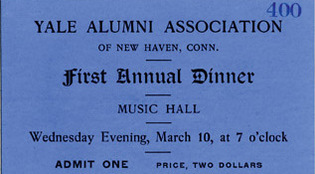 loading
loading
Old YaleA club for YaliesJudith Ann Schiff is chief research archivist at the Yale University Library.  Manuscripts & ArchivesTwo bucks got you a ticket to the Yale Club of New Haven's inaugural event. Cocktails and cigars were extra. View full imageOn March 10, 1909, a banquet for 300 Yale alumni was held in New Haven at the Music Hall on Court Street. At two dollars per ticket, the menu featured Cape Cod oysters, fried smelts, broiled Philadelphia squab, and Pall Mall cigarettes; the cash bar offered Martini and Manhattan cocktails for 15 cents and Flor de Cuba Perfectos for 25 cents. Also on the menu was "Yale Alumni salad." (No specifics were provided as to the ingredients.) This was the official founding event of the Yale Alumni Association of New Haven. At 100, the club is a relative newcomer among Yale alumni associations. The earliest official alumni groups were the Yale College class organizations, which date back to the first class officer elections in 1792. The first association of local alumni was the Cincinnati Yale Club, founded in 1864. In his Centennial History of the club, Herbert F. Koch explained that its formation was motivated by the death of "one of the college's best loved professors," chemist and science teacher Benjamin Silliman, Class of 1796. After Silliman's death in November 1864, Alphonso Taft ’33 -- father of William Howard Taft ’78 and co-founder of Skull and Bones -- called a meeting of all "resident or sojourning graduates of Yale College," to "take note" of Silliman's passing and "draw up proper resolutions." At the gathering, participants decided that "the common bond between them should be continued." Within a few years, alumni associations were organized in Boston, Chicago, Philadelphia, Washington, and New York. (In 1908, a Boston paper would note that the local club "has always been a very keen, zestful organization, owing, perhaps, in part at least, to the fact that Yale is so far in the minority here.") On December 3, 1908, the Yale Alumni Weekly published an anonymous letter expressing the writer's astonishment that there was no alumni association in New Haven. Most faculty members at the time were Yale graduates, after all, and many other alumni lived in greater New Haven. By the end of the month, plans had been made to organize a club. The letter of invitation to the banquet asserted that there were "nearly fifteen hundred male graduates of Yale, most of whom after graduation have no affiliations with the University." (No alumnae were invited, although, according to the university's current estimate, by 1900 Yale had a few hundred women enrolled for study every year in the graduate school, art school, and music school combined.) Annual dues were one dollar. The association's initial purpose, as expressed in its constitution, was "to cultivate social relations among Yale men in New Haven and its vicinity, and to extend the influence of Yale University." In 1911, it was amended as follows: "and to help in such ways as may be deemed best to increase the benefit which Yale University and the city of New Haven may derive from each other." One of the more noteworthy annual dinners of the early years was held in 1913, when the Yale Glee Club performed -- with an undergraduate named Cole Porter ’13 -- and "a very novel and interesting entertainment" was given: "motion pictures" of the 1912 Yale-Princeton football game, the Cambridge-Oxford boat race, "and the full moving picture story of the great Olympic Games." The initial membership of about 100 rose steadily until it leveled off to about 450 in 1916. In 1917, the association realized a dream to "establish a series of scholarships" for "boys living in the territory." The first scholarship was awarded to a New Haven Hillhouse High School student, Bernard Robbins ’21. It was not until 1959 that wives were invited to attend the annual meetings. In 1960, the group changed its name to the Yale Club of New Haven. During 2009-10, the club is celebrating its centennial with a series of lectures, concerts, and other events. Members continue to raise funds for scholarships to Yale: during 2008-09, the club awarded $235,000 to 47 undergraduates, $39,000 to 13 graduate students, and $7,500 to 2 special students. In addition, the club provided nearly $100,000 to support student internships and service activities. To the best knowledge of historians of Yale, its alumni were the first graduates of any U.S. university to form alumni associations. In addition to classes and local clubs, Yale alumni are organized in boards, assemblies, schools, diverse interests, and regional clubs. Today there are more than 140 domestic Yale clubs and associations and more than 40 international clubs. For most alumni, the clubs provide grassroots connections to Yale, between Yale and their communities, and to fellow alumni across the university. The lyrics of a song printed in the Boston Yale Club 1868 dinner program convey, perhaps, the boosterish spirit of Yale clubs in the past. The reference to "memory's light," so similar to a phrase in "Bright College Years" yet printed 20 years before its composition, speaks also to the nostalgia that is one of the reasons why Yale clubs and associations continue to thrive today:
The comment period has expired.
|
|